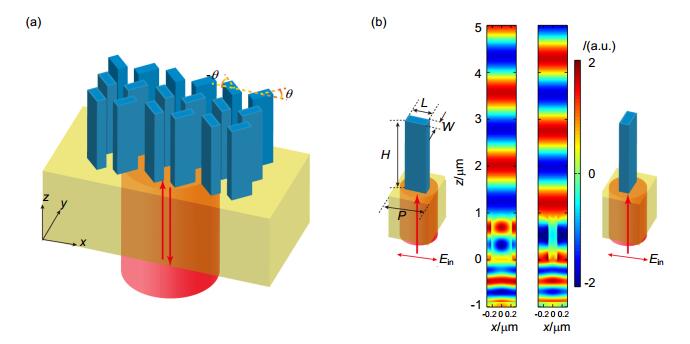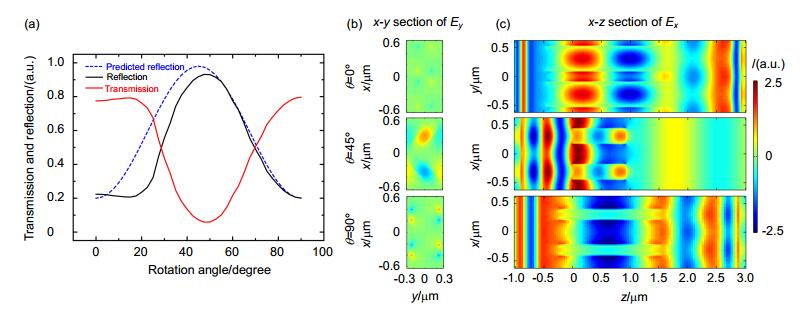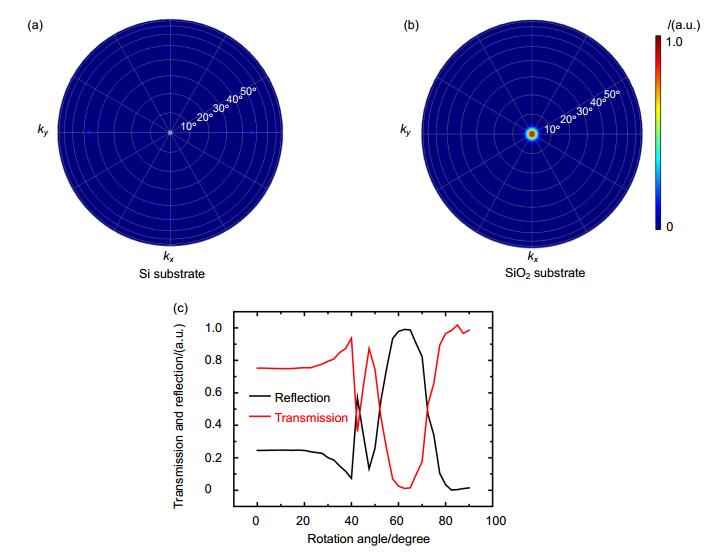-
Abstract:

Reflection engineering plays an important role in optics. For conventional approaches, the reflection tuning is quite challenging in a loss-free component. Therefore, a simple approach to tune the reflection is highly desired in plenty of applications. In this paper, we propose a new design of metasurface with just one single layer dielectric structure to tune the reflection of an interface by destructive interference in a subwavelength scale. By arranging the orientation of nano-antennas, the reflectivity tuning from 20% to 90% can be achieved at the wavelength of 1550 nm. Moreover, such reflectivity tuning of the designed metasurface works at the tunable wavelength from 1500 nm to 1600 nm. This ultra-thin solution can achieve similar performance as the traditional bulky components without diffraction orders, while the design and fabrication are much simple and flexible. The ultra-thin and tunable properties indicate the great potentials of this method to be applied in laser fabrication, optical communication and optical integration.
-
Key words:
- metasurface /
- reflection /
- tunable /
- destructive interference
-

Abstract:Reflection is one of basic optical phenomena, which has extensive applications in various optical systems, such as reflective mirror, laser cavity, coupler and lens. For these applications, the requirements are different. For instance, reflective mirror requires a high reflectivity but lens requires a high transmittance. Conventionally, reflection components mainly rely on the reflective coating. For the metal coating, the loss cannot be avoided, which limits its applications in high-power laser cavity and has low tunability in spectral response. For the dielectric coating, multi-layer design is required. It is not only sophisticated in design but also complicated in manufacturing, especially when the devices require different reflecivities. For the applications that require spectral filtering to reduce noise for particularly wavelengths or the spatial filtering for the special transmission mode, the design becomes even more difficult. Therefore, it is highly demanded to propose a feasible solution that can easily achieve the flexible control of reflection by a simple manufacturing process. It would be favorable for many devices if we can design a strategy that provides a large range of reflection tuning with a simple fabrication process. Metasurface is an array of scattering elements with sub-wavelength dimensions and periods, which can provide electromagnetic properties in demand. It is well-known for its capability of controlling light properties, such as wavefront, phase, and polarization. Furthermore, it is also favorable for industry as the fabrication process is compatible to the current semiconductor manufacturing. Hence, a single layer metasurface has great potential to replace traditional reflective components by a proper design. In this paper, we propose a new design of metasurface with just one single layer dielectric structure to tune the reflection of an interface by destructive interference in a subwavelength scale. By arranging the orientation of nano-antennas, the reflectivity tuning from 20% to 90% can be achieved at the wavelength of 1550 nm. Moreover, such reflectivity tuning of the designed metasurface works at the tunable wavelength from 1500 nm to 1600 nm. A design for the reflection without high diffraction orders is also proposed by a high refractive index silicon antenna on a low refractive index silica substrate, which can achieve about 0.1% ~ 98% reflection after optimization. It can achieve similar performance as the traditional bulky components without diffraction orders, while the design and fabrication are much more simple and flexible. The ultra-thin and tunable properties indicate the great potentials of this method to be applied in laser fabrication, optical communication and optical integration.
-

-
Figure 2. Reflection characterization. (a) The transmission and reflection of metasurface at various rotation angles. (b) x-y section of Ey distribution in optical antenna at 0°, 45° and 90° rotation angles, respectively. (c) x-z section of Ex distribution in optical antenna at 0°, 45° and 90° degree rotation angles, respectively.
-
[1] Born M, Wolf E. Principles of Optics: Electromagnetic Theory of Propagation, Interference and Diffraction of Light[M]. 7th ed. Cambridge: Cambridge University Press, 1999.
[2] Stepanov D Y, Corena L. Bragg grating fabrication with wide range coarse and fine wavelength control[J]. Optics Express, 2014, 22(22): 27309-27320. doi: 10.1364/OE.22.027309
[3] Heavens O S. Thin-film optical filters[J]. Optica Acta: International Journal of Optics, 1986, 33(11): 1336.
[4] Yu Nanfang, Capasso F. Flat optics with designer metasurfaces[J]. Nature Materials, 2014, 13(2): 139-150. doi: 10.1038/nmat3839
[5] Li Yang, Li Xiong, Pu Mingbo, et al. Achromatic flat optical components via compensation between structure and material dispersions[J]. Scientific Reports, 2016, 6: 19885. doi: 10.1038/srep19885
[6] Li Yang, Li Xiong, Chen Lianwei, et al. Orbital angular momentum multiplexing and demultiplexing by a single metasurface[J]. Advanced Optical Materials, 2017, 5(2): 1600502. doi: 10.1002/adom.v5.2
[7] Ni Xingjie, Ishii S, Kildishev A V, et al. Ultra-thin, planar, Babinet-inverted plasmonic metalenses[J]. Light: Science & Applications, 2013, 2(4): e72. https://engineering.purdue.edu/~shalaev/Publication_list_files/LSA_Ni_2013.pdf
[8] Luo Xiangang. Principles of electromagnetic waves in metasurfaces[J]. Science China: Physics, Mechanics & Astronomy, 2015, 58(9): 594201. https://link.springer.com/article/10.1007/s11433-015-5688-1
[9] Zheng Guoxing, Mühlenbernd H, Kenney M, et al. Metasurface holograms reaching 80% efficiency[J]. Nature Nanotechnology, 2015, 10(4): 308-312. doi: 10.1038/nnano.2015.2
[10] Khorasaninejad M, Chen Weiting, Devlin R C, et al. Metalenses at visible wavelengths: Diffraction-limited focusing and subwavelength resolution imaging[J]. Science, 2016, 352(6290): 1190-1194. doi: 10.1126/science.aaf6644
[11] Pu Mingbo, Li Xiong, Ma Xiaoliang, et al. Catenary optics for achromatic generation of perfect optical angular momentum[J]. Science Advances, 2015, 1(9): e1500396. doi: 10.1126/sciadv.1500396
[12] Aieta F, Genevet P, Kats M A, et al. Aberration-free ultrathin flat lenses and axicons at telecom wavelengths based on plasmonic metasurfaces[J]. Nano Letters, 2012, 12(9): 4932-4936. doi: 10.1021/nl302516v
[13] Chen Xianzhong, Huang Lingling, Mühlenbernd H, et al. Dual-polarity plasmonic metalens for visible light[J]. Nature Communications, 2012, 3: 1198. doi: 10.1038/ncomms2207
[14] Arbabi A, Horie Y, Bagheri M, et al. Dielectric metasurfaces for complete control of phase and polarization with subwavelength spatial resolution and high transmission[J]. Nature Nanotechnology, 2015, 10(11): 937-943. doi: 10.1038/nnano.2015.186
[15] Lin Dianmin, Fan Pengyu, Hasman E, et al. Dielectric gradient metasurface optical elements[J]. Science, 2014, 345(6194): 298-302. doi: 10.1126/science.1253213
[16] Xiao Shumin, Drachev V P, Kildishev A V, et al. Loss-free and active optical negative-index metamaterials[J]. Nature, 2010, 466(7307): 735-738. doi: 10.1038/nature09278
[17] Jahani S, Jacob Z. All-dielectric metamaterials[J]. Nature Nanotechnology, 2016, 11(1): 23-36. doi: 10.1038/nnano.2015.304
[18] Landy N I, Sajuyigbe S, Mock J J, et al. Perfect metamaterial absorber[J]. Physical Review Letters, 2008, 100(20): 207402. doi: 10.1103/PhysRevLett.100.207402
[19] Li Zile, Zheng Guoxing, He Ping'an, et al. All-silicon nanorod-based Dammann gratings[J]. Optics Letters, 2015, 40(18): 4285-4288. doi: 10.1364/OL.40.004285
[20] Li Yang, Huang Q, Wang D C, et al. Polarization-independent broadband terahertz chiral metamaterials on flexible substrate[J]. Applied Physics A, 2014, 115(1): 57-62. doi: 10.1007/s00339-013-8002-y
[21] Keshavarz Hedayati M, Elbahri M. Antireflective coatings: Conventional stacking layers and ultrathin plasmonic metasurfaces, a mini-review[J]. Materials, 2016, 9(6): 497. doi: 10.3390/ma9060497
[22] Rong Haisheng, Jones R, Liu Ansheng, et al. A continuous-wave Raman silicon laser[J]. Nature, 2005, 433(7027): 725-728. doi: 10.1038/nature03346
-


 E-mail Alert
E-mail Alert RSS
RSS

 下载:
下载:






